You know that moment when you are looking for something, but end up finding something else? Something you were not expecting to find? Something you didn’t even know you wanted to find? I had one such moment about 10 days back.
I was headed to Agra the next day for a conference and hoped to squeeze in a visit to the Agra Fort. While checking the Fort timings on it’s official website, I came across a link to lesser known monuments in the city. Curious to know more, I clicked on the link and my eyes were immediately drawn to the photograph accompanying the second entry on the page — a red domed structure with four minarets in each corner, not unlike a Taj Mahal, but red in colour.

Wondering which Mughal prince or noble was buried in this very obvious example of Islāmic architecture, I proceeded to read the description. And then read it again just to make sure that what I had read was indeed what I read the first time.
The Red Taj Mahal or John William Hessing’s Tomb was built by his wife in the memory of her husband. If Taj Mahal is known for the love of a husband for his wife, then on the other hand, the Red Taj Mahal is known for the love of a wife for her husband…
This was no mausoleum of a Mughal prince or noble or even a Muslim; this was a Christian’s tomb located in the Agra’s Roman Catholic Cemetery. Reading about this rather intriguing place, I was surprised that I had neither heard of nor come across the Cemetery and the ‘Red Taj Mahal’ before, in spite of having visited Agra in 2011! There was only one way to remedy this. Visit it.
And that’s exactly what I do when I visited Agra earlier this month. 🙂
Finding the Cemetery, though, was easier said than done, but with the help of Google Maps and a determined cab driver, we arrived at around 10 in the morning. It was a warm day, but the large trees in the Cemetery provided much-needed shade and relief from the sun, as well as the sound of traffic beyond the Cemetery walls. We were the only visitors there, though I noticed a man napping in the shade and also a couple of men cutting the overgrown grass in the Cemetery. It was so quiet and peaceful that the only sounds I heard were that of the men singing, some birdsong and the chittering of squirrels.
 The first glimpse of the ‘Red Taj Mahal’ was a bit surreal. Even though I knew that it was a Christian Mausoleum, the Islāmic style architecture was …well… distracting. As were some other cenotaphs that looked like the Hindu chhatris I saw in Rajasthan, but with a twist — they had a cross on top of the dome.
The first glimpse of the ‘Red Taj Mahal’ was a bit surreal. Even though I knew that it was a Christian Mausoleum, the Islāmic style architecture was …well… distracting. As were some other cenotaphs that looked like the Hindu chhatris I saw in Rajasthan, but with a twist — they had a cross on top of the dome.
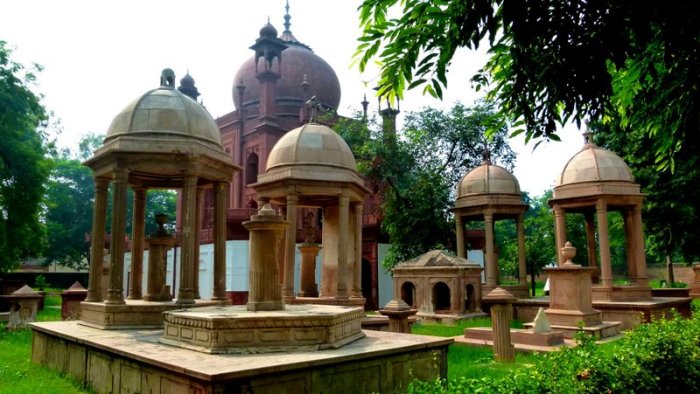

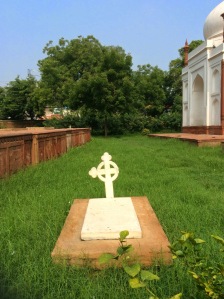 The origin of Agra’s Roman Catholic Cemetery goes back to the mid-1500s during the period of Emperor Akbar’s reign. A community of Armenian Christians traders and merchants had settled in the city and were given land to bury their dead. In the decades and centuries that followed, the Cemetery also became the burial-place for Christians, especially the more prominent ones who died in North India during the Mughal period and the colonial period that followed.
The origin of Agra’s Roman Catholic Cemetery goes back to the mid-1500s during the period of Emperor Akbar’s reign. A community of Armenian Christians traders and merchants had settled in the city and were given land to bury their dead. In the decades and centuries that followed, the Cemetery also became the burial-place for Christians, especially the more prominent ones who died in North India during the Mughal period and the colonial period that followed.
I must clarify that by Christians, I mean Europeans, as a walk around the Cemetery revealed. It was also a walk that revealed changes in grave / tomb / mausoleum styles over the 450-odd years of the Cemetery. The earliest graves are simple with just a memorial slab marking the site and giving details of the person buried in the Armenian language. Some gravestones have inscriptions in both Armenian and Persian.


Then there are recent graves that go beyond just a simple gravestone and have elaborate urns, columns, pyramids, cones and cubical structures as tombs with inscriptions in English or French and sometimes in Armenian and Persian as well.

Once I saw the less grand, but not necessarily unimportant graves, I moved on to explore not only the larger and grander mausoleums, but also the historically significant ones: for example Marty’s Chapel, the oldest structure in the Cemetery.
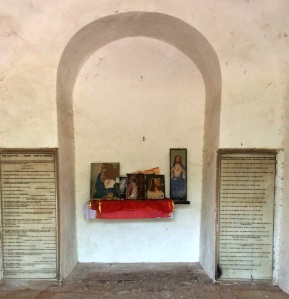 An octagonal structure with a dome, the Chapel has the grave of the oldest resident of the Cemetery — Khwaja Mortenepus Armenian (d.1611) — located inside the chapel. Khwaja’s marble gravestone with an English inscription, however, appears to be a later addition — perhaps as a replacement to the original damaged one or to signify its importance as the oldest grave in the cemetery. On either side of the altar are marble slabs (again a later addition?) with names of Jesuit priests buried in the Cemetery.
An octagonal structure with a dome, the Chapel has the grave of the oldest resident of the Cemetery — Khwaja Mortenepus Armenian (d.1611) — located inside the chapel. Khwaja’s marble gravestone with an English inscription, however, appears to be a later addition — perhaps as a replacement to the original damaged one or to signify its importance as the oldest grave in the cemetery. On either side of the altar are marble slabs (again a later addition?) with names of Jesuit priests buried in the Cemetery.
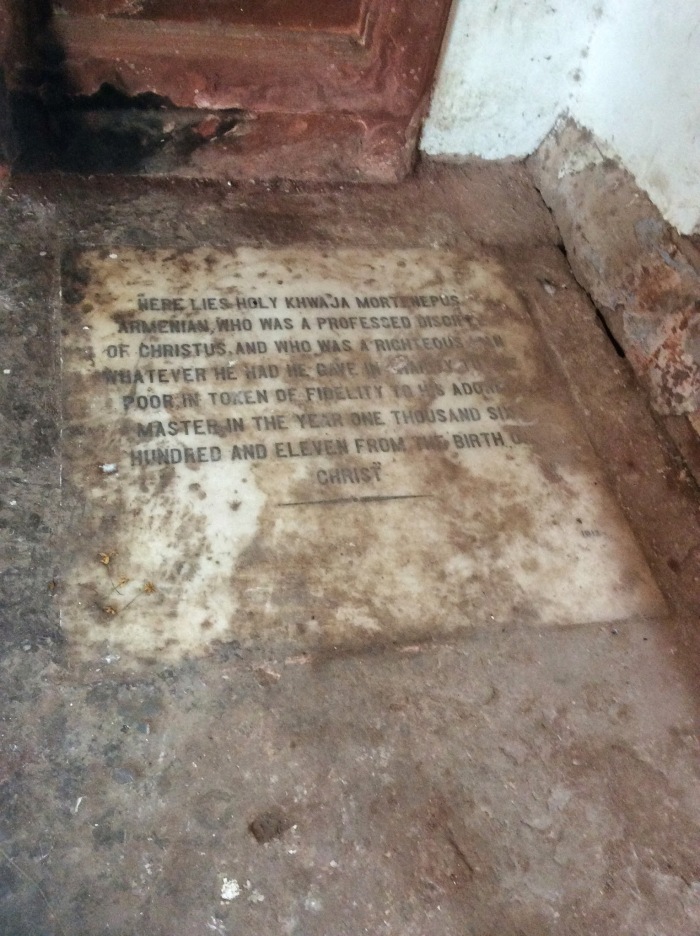
The Europeans buried in the Cemetery include Portuguese Jesuit priests, Italians, the French, Germans, the Dutch and the English. In fact, the first Englishman to be buried on Indian soil, John Mildenhall, is here in this Cemetery. Mildenhall’s grave, which has reportedly been restored, says that he left London in 1599 and travelled to India through Persia, reaching Agra in 1603, where he got an audience with Emperor Akbar. He
fell ill in Lahore in 1614 and died in Ajmere and was buried here through the good offices of [one] Thomas Kerridge Merchant.

Then there is the mausoleum of Francis Ellis who died on 14th January 1868. The tombstone says,
“This monument has been erected as a last token of affection by his disconsolate widow and three sons John, George and James with a fervent hope through Jesus Christ of meeting him in Heaven.”
The platform on which the Ellis Mausoleum is built also has the graves of the Ellis family — all 23 of them. While reading the inscriptions, it was quite sad to see so many Ellis children die at infancy making me wonder at the cause of death. One Ellis child died at 22 days !
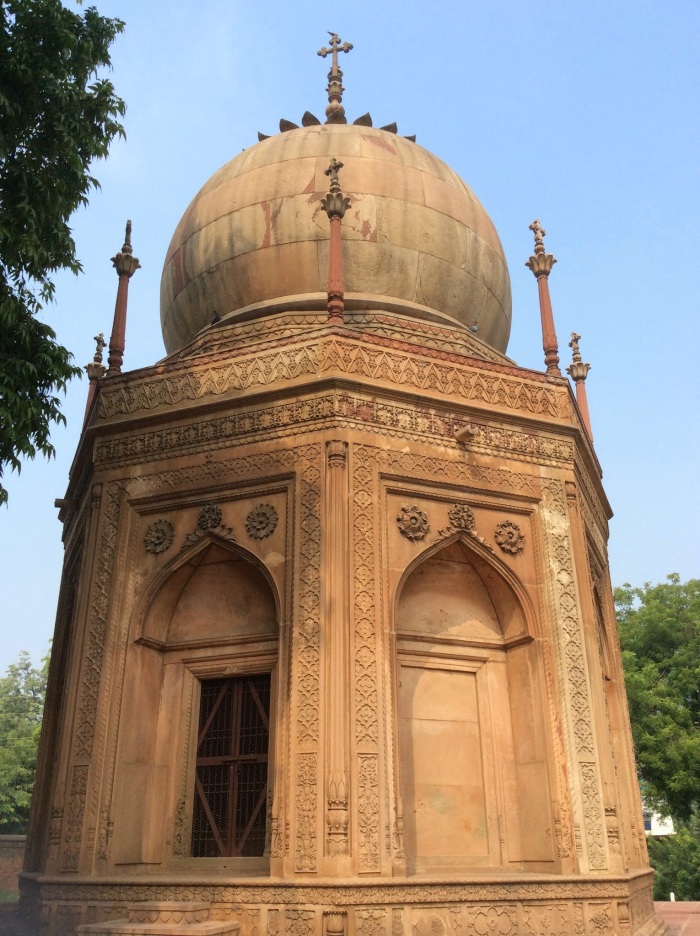 The star of the Roman Catholic Cemetery is the Red Taj Mahal or the tomb of John William Hessing, who died on 21st July 1803 in the service of the Maharaja Daulat Rao Scindia. At that time, Agra was under the rule of the Marathas (Scindia) and Hessing was the Commander of the Agra Fort. Hessing’s mausoleum was commissioned by his wife Anne Hessing. Looking at the structure, it is quite obvious, where the inspiration came from. At this point, I request you to go and look at the first picture in this post. 🙂
The star of the Roman Catholic Cemetery is the Red Taj Mahal or the tomb of John William Hessing, who died on 21st July 1803 in the service of the Maharaja Daulat Rao Scindia. At that time, Agra was under the rule of the Marathas (Scindia) and Hessing was the Commander of the Agra Fort. Hessing’s mausoleum was commissioned by his wife Anne Hessing. Looking at the structure, it is quite obvious, where the inspiration came from. At this point, I request you to go and look at the first picture in this post. 🙂


 As I walked around the Cemetery, it was with a realisation how my pre-conceived notions led me to experience this visit to the Cemetery, at least to begin with. Initially, it was the Islāmic architecture for a Christian tomb that surprised me. Then it was the Persian inscriptions on the gravestones that confused me. And finally the choice of stone for the tombs / mausoleums / gravestones.
As I walked around the Cemetery, it was with a realisation how my pre-conceived notions led me to experience this visit to the Cemetery, at least to begin with. Initially, it was the Islāmic architecture for a Christian tomb that surprised me. Then it was the Persian inscriptions on the gravestones that confused me. And finally the choice of stone for the tombs / mausoleums / gravestones.
Having seen them only in marble, basalt, granite and limestone in sober shades of white, black and grey, the vivid shades of red and pink came as a bit of a shock. Particularly since sandstone is my favourite stone and its very colour represents life to me.
I found it disconcerting to see something that symbolises life being used to mark the site of the dead. But then, I ask myself, doesn’t a tomb or a grave also represent a life that once lived on earth? And also, isn’t it wonderful how local design sensibilities inspired the mausoleums for a then ‘new religion’ in the region?
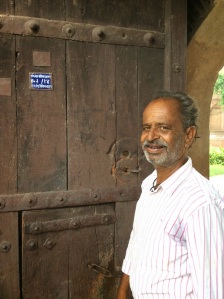 I spent an hour or so at the Roman Catholic Cemetery. I was rather lucky to have the caretaker of the Cemetery, Suren Singh, show me around the place, and open the locked doors of the mausoleum so that I could have a closer look.
I spent an hour or so at the Roman Catholic Cemetery. I was rather lucky to have the caretaker of the Cemetery, Suren Singh, show me around the place, and open the locked doors of the mausoleum so that I could have a closer look.
There was only one problem though, I could barely understand what he said as his mouth was full of paan. However, there were three things that I clearly understood — (i) this property was maintained by the Archaeological Survey of India, (ii) hardly anyone visited the Cemetery, and (iii) burials happened at the Cemetery even today.
When Suren Singh pointed towards a freshly dug mound covered with flowers in one corner of the Cemetery, I took that as my cue to thank him and leave.
Notes:
- There are a couple of other mausoleums that look interesting and I visit them, but due to lack of information and confusion as to who is buried there, I’m not including them in the post. One of the tombs is said to have Zakur of Tabriz and the other Walter Reinhardt, a European mercenary.
- The Roman Catholic Cemetery is on M.G. Road and next to Bhagwan Talkies and is open for visitors from sunrise to sunset.
- If you do visit the Cemetery or any graveyard for that matter, please respect the dead. Do not walk or climb over the gravestones. And if there is a burial happening, please respect the privacy of the mourners and leave.
- For more details on the Cemetery, please do read this excellent blogpost by Patrick A. Rogers.
Read more about other places to visit in Agra:

WOW….. India never ceases to amaze me. Its amazing to discover that there are soooooo many thing about my own country I do not know. And sad at the same time to think that we are not really utilizing the amazing beauty and varied things we have. We are not taking care of them… makes me sad.
LikeLiked by 1 person
Shraddha, the Roman Catholic Cemetery was actually very well maintained. Due to the rains, the grass was overgrown and they were in the process of clearing it. According to the caretaker, by November 2nd, which is All Souls Day, the Cemetery is completely cleaned and spruced up and any repairs required carried out.
I would say that the Cemetery is better maintained than many other monuments that I have seen.
As for your statement “we are not really utilizing the amazing beauty and varied things we have”, I agree with you 100%
LikeLike
What beautiful photographs! Superb!
LikeLiked by 1 person
Thank you, Sindhoo. The real thing, that is the Roman Catholic Cemetery, is far more beautiful and peaceful. Do visit it, if you get the chance.
LikeLike
We passed this place on our way from one Mughal monument to another on a hot mid-April afternoon. Our driver was quite dismissive of our enquiries and because of the heat we did not assert ourselves. A mistake, it seems in retrospect. Sigh!
LikeLiked by 1 person
Unfortunately, mistakes are always realised in retrospect. 😦
LikeLike
Wow sudha! What a beautiful and interesting place to ‘discover’ !!!! I can’t wait to go see it for myself!! I wonder why the Europeans built tombs like this. Were they impressed by the Taj and the other mausoleums? Did they attempt to blend in?? In any case, this shows the stark difference between the first Europeans who came here and the later ones. The former tried to become one with India, the latter made India their own!! This was so apparent even at Kochi. What do u think???
LikeLiked by 1 person
Yayy ! Anu, you called me a discoverer. Nobody’s ever called me that before 😛
I think there were a lot of reasons for the tombs to be the way they were.
(i) the Europeans were not yet colonisers in the late 1500s and early 1600s, At that time it was important for them to blend in. Maybe they really loved the local design, maybe they did not – we’ll never know.
(ii) Local artisans had no idea of what European tombs and gravestones were supposed to look like. So the graves looked Islamic, but with a cross.
(iii) As colonisation spread, converts increased and more people from Europe from all walks of life started coming to India, their designs spread, which is why the later tombs and gravestones are distinctly European.
The earliest examples of Indo-Islamic architecture in Western India is at Champaner (which I hope you will visit soon). The amount of ‘Hindu’ elements in the mosques of Champaner, especially the Jami Masjid is astounding. From lattice work that look like kolams, to jharokhas to the central mihrab which looks like a ‘kalash’ you have it all.
So in a sense the initial thing to do is to assimilate with the local and later on make your own design as the ‘local’.
LikeLike
I hope I can go to Champaner soon, Sudha! sigh! the list of places I want to go is always increasing!
I can understand the local influence, since they used local artisans. that was something i heard of, even at Goa. It is interesting to see how the architecture has changed over the years. But more interesting is the assimilation of local styles, traditions and concepts.
However, there was also a difference in the way the earlier visitors looked at the country. they wanted to blend in, to understand this way of life. they were curious about the secrets it held. the latter ones, the colonists, were more interested in settling a new colony…a bit of their country in the new land. i think it marks the essential difference between them.
in a sense, the same thing is happening now, in the opposite way. the earlier NRIs blended into, and became more western in their ways. now, we have more temples, and temple visitors there than here, more of them follow traditions and customs than here…they are more indian than indians, in a way! tit for tat, can we say???
LikeLike
Interesting. Never looked that closely ever. The thought also never entered my mind. Thought provoking also…
LikeLiked by 1 person
Yes, the Roman Catholic Cemetery is indeed an interesting place. Have you heard of it before or visited it perhaps?
LikeLike
Sudha, as always, you draw our attention to what is missed so often and bring into visibility its beauty! Best wishes, Rajshri.
LikeLiked by 1 person
Thank you Rajshri. I always value your comments and observations. And you do know which place to visit whenever you’re in Agra, right? 🙂
LikeLike
very informative and colorful post
LikeLiked by 1 person
Thank you very much, Yogi. Glad you liked the post. 🙂
LikeLike
What a lovely post and what an amazing discovery. A Christian/ Armenian/ Roman Catholic cemetery that dates back to the Mughal period! Fascinating. Loved your descriptions (I could almost visualise the caretaker chewing on his paan) and loved the pics too. 🙂
LikeLiked by 1 person
Thank you, The Weekend Baker. 🙂
I can’t tell you what a lucky discovery this was. If I had not wanted to visit the Agra Fort and checked the timings, I would not have come across information on this Cemetery. It was serendipity. Do visit this Cemetery whenever you go to Agra.
And of course, the visit itself was so good. The paan chewing caretaker sure added character to the visit. D
LikeLike
I’m glad I stumbled upon your blog and discovered about this Red Taj Mahal and a christian’s tomb dedicated to him by his wife! Lovely! I am sure to visit this place whenever I visit Agra. 🙂 Thank you!
LikeLiked by 1 person
Welcome here, Renucas. Thank you so much for stopping by and commenting. I’m glad you came here too as places like the Red Taj Mahal needs the love and appreciation of people like you.
Hope to see you around on the blog 🙂
LikeLike
excellent informative post
LikeLike
Welcome to my blog, Noucha.Thank you very much for stopping by and commenting. Very very that you liked the post and found it to be informative. Keep visiting ! 🙂
LikeLike
sure! I will look for other adventure stories from your blog
LikeLike
I was not aware that the Christian community existed during the reign of Akbar. You have enlightened me. Thank you for sharing this blog. Hope to read more such interesting articles from you about the various historical monuments of India.
LikeLike
Did you go up to the top of the Red Taj Mahal? We had been lucky to go all the way to the terrace with the caretaker. Good view of the other graves/memorials from the top. And yes, the guy who took us around was not very clear but we made out most of what he said!!!
LikeLike
No, we didn’t. I didn’t even know that we could go up to the top ! Lucky you.
LikeLiked by 1 person
Brilliant and informative post. I am currently in Agra and visited the cemetery yesterday. I came across your post by googling to find out more about who the Ellis family were.
LikeLike
Hello Philippa. Welcome to “My Favourite Things” and thank you so much for stopping by and commenting. As you know, the cemetery was a lucky find and I’m so happy that I did eventually find the place and enjoy my visit as well. Historically, the place is quite significant and I wonder why other Indians don’t visit it.
LikeLike
I travel India a lot and try and get in depth, I was spending 4 days in Agra and whilst I didn’t fall in love with it as I do most places in India, 4 days wasn’t enough and I found it fascinating.. So much to discover. I plan on writing about it but sadly not quite so eloquently as you have
LikeLike
What an amazing discovery! Thank you for writing about. Always a delight stumbling upon unheard and unmentioned gems on your blog.
LikeLike
writing about this*
LikeLike
Thank you so much for your kind words, Elita. Whenever you visit Agra, don’t miss out on this little gem. Finding it may be an issue, but you’ll get there, just like I did.
I’m really surprised that many people don’t know about this or visit it. Though this site is there on the UP tourism website, it is ironical that they don’t ptomote it themselves. In the recently concluded Uttar Pradesh Travel Writers Conclave, I was rather amused to see the same places being mentioned and visited by the travel bloggers, sorry writers, who visited Agra. No one seemed to have visited this beautiful site. What a collosal waste of an opportunity I say.
LikeLike